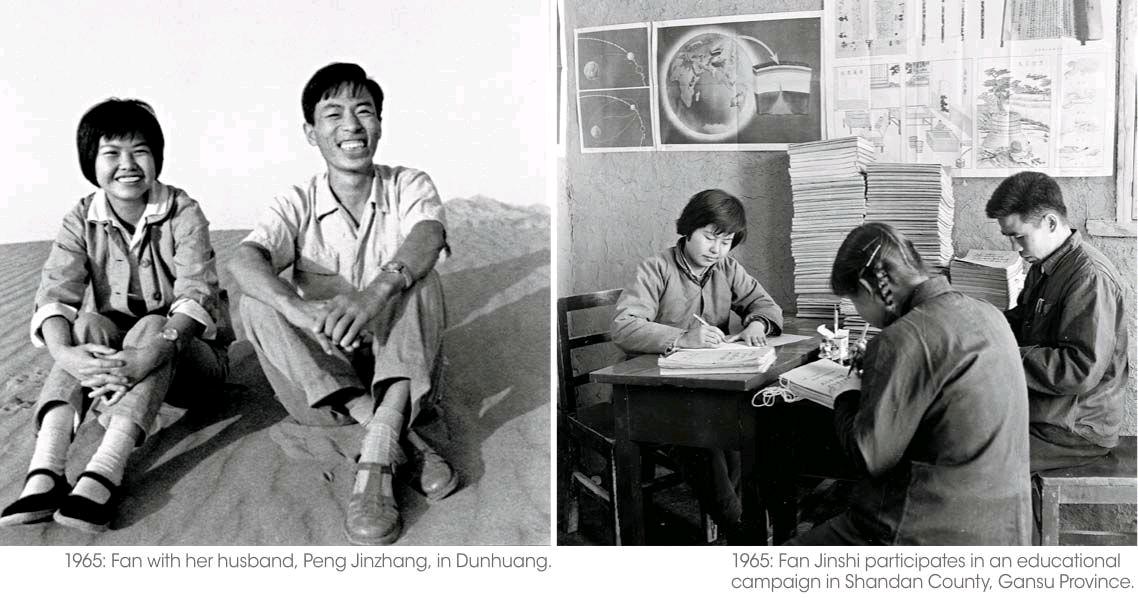Fan Jinshi:A Lifetime of Devotion
by+Huang+Liwei
Fan Jinshi was born in Beijing and raised in Shanghai. After graduating from Peking University in 1963, she was dispatched to work in Dunhuang, and now serves as president of Dunhuang Academy. It has been 51 years since Fan began studying and protecting the Dunhuang Grottoes as well as disseminating Dunhuang culture. “I was meant to be part of Dunhuang,” she asserts.
“The benefits of your work are beyond measure,” appraised Ji Xianlin, a great master of Chinese culture, at the celebration of the 100th anniversary of the discovery of the Dunhuang Grottoes in 2000.
Fan will never forget when she first visited Dunhuang in 1962 while interning before graduation from the Archaeological Department of Peking University.
However, the land that appeared so dreamy in books turned her expectations upside down. Growing up in a massive modern metropolis, Fan could hardly become accustomed to local conditions and soon fell ill. Still, she didnt hesitate to accept any opportunity to go to Dunhuang after graduation, when assigned a job there.
Along with sharing the values of many young people of the time, who desired to serve the country, Fan was also driven towards her path by inspiration from Chang Shuhong, then head of the Dunhuang Art Institute, who devoted his life to the study of Dunhuang culture. Chang was the first director of the Dunhuang Art Institute. He gave up a career and comfortable urban life to live and work in Dunhuang, a locale with extremely poor living conditions. In fact, in the 1940s, Chang was living in Paris and had become a standout in French art circles when he first saw a book about Dunhuang. He was so inspired that he threw his life into the clean-up and protection of the Dunhuang Grottoes by establishing a research institute specializing in Dunhuang art.
Fan was so moved by Changs persistence and perseverance that she followed her predecessors path and devotedly guarded the grottoes for over half a century.
The most fundamental task related to the study of the Dunhuang Grottoes is investigation and measurement of caves. Fan started her Dunhuang career from scratch and eventually completed the chronicling of the Dunhuang Grottoes dating from different periods: Northern Dynasties (386-581), Sui Dynasty (581-618), and Tang Dynasty (618-907). Not only has her achievement in dating the caves been widely acclaimed, but it also laid a solid foundation for further study of the grottoes.

In 2011, Fan oversaw the publication of the Report on Archaeological Study of Cave 266-275 in the Mogao Grottoes, the first volume of Collected Works of the Dunhuang Grottoes, after painstaking efforts to collect data from 11 caves through the most sophisticated means, including mapping, surveying, and photography.
The report is of great value for the preservation, inheritance and sustainable study of the Dunhuang Grottoes and feeds the demands of academics from China and beyond. It also serves as a blueprint for the overall restoration of the caves which have deteriorated tremendously.
Fan attributes much of her success to support from Peng Jinzhang, her archaeologist husband.
They met as classmates in college. After graduation, Fan headed to Dunhuang and Peng to Wuhan University some 2,000 kilometers away, where he established its Archaeology Department. In 1986, he finished his research on the Shang and Zhou dynasties (1600-221 B.C.) and transferred to the Dunhuang Academy to study Buddhist archaeology.
He spent eight years sorting structures north and south of the Mogao Grottoes Temple through the study of relics discovered in caves in the northern area, increasing the number of documented caves from 492 to 735.
Preservation is always the top priority for any efforts concerning Dunhuang. In 1998, Fan Jinshi, who could have instead retired, became the third president of Dunhuang Academy.
Thriving tourism has endangered Dunhuang. In 1979 when it first opened, the Mogao Grottoes attracted less than 20,000 visitors. In 2012, annual visits topped 800,000, and the daily rate hit 18,000. The development of tourism alongside the preservation of Dunhuang has turned into a big concern.
The most sophisticated scientific and technological methodologies are being used to manage the Dunhuang Grottoes environment, caves, safety protection, and tourist administration thanks to Fans great endeavors. A system for daily maintenance and monitoring was established, enabling preventive protection and administration.
Dunhuang Academy has formulated a comprehensive set of measures for tourist administration. Caves are open alternately. During the peak season, visitors have to make reservations to avoid the peak hours. Routes are adjustable. Exhibition centers are open for free. And guides are better trained.
Today, tourists visit the Mogao Grottoes in an orderly manner. The maximum size is limited to 25 in one cave. Guides work with a headset mic and flashlight to minimize the damage to the cave.
Since the mid-1980s, Fan Jinshi has worked hard to cooperate with international research institutions in Japan, the United States, Australia, and Britain to enhance the protection and management of the Dunhuang Grottoes. The founding of the digitalization center in 2006 brought a new look to Dunhuang art and upgraded the study and protection capacity of the Dunhuang Academy.

